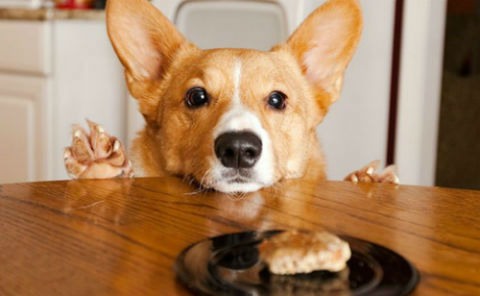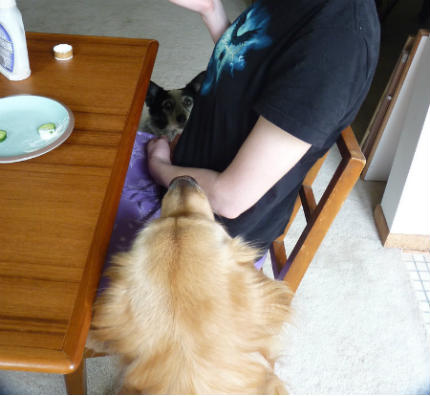Although the dog's food is something that should normally be kept constant and without variations, at certain stages of its life, or under certain treatments, a change in diet may be necessary . Here we give you a summary of how you can do it step by step in a safe way for your pets, even puppies, also considering some complications that may arise in the food transition process and how you can resolve them in the best way.

The dog's digestive system
We must begin by understanding that our dog's digestive system is very different from the human one, and while it is more nutritious for us to have a changing diet with multiple foods, due to the bacteria found in our pet's body, they A constant diet is best for them , that is, it is healthier to eat the same type of food every day.
The dog has a greater problem coping with a change in diet, which is why, if we simply change their feed from one day to the next, it is likely that we will cause diarrhea or other eating disorders, which is why we must plan to carry out a change. gradual diet change .
Make sure it is the right time for the food transition
The first thing we must do is be certain that the time has come to change our pet's diet. The most common reason is due to age, although remember that it is recommended to consult with your veterinarian, since the maturation process is different for each breed, for example small dogs normally only require a few months to stop being considered puppies, although breeds Large ones should spend up to more than a year, and sometimes almost two, with the same type of initial food.
Improving the quality of your pet's feed is also another reason to make a dietary transition, as this can allow it to improve its health, physical condition, and of course also its appearance with a shinier coat.
For health reasons , changes in a dog's diet may also be required, and unless it is an urgent change indicated by the veterinarian, the process should be carried out gradually.

How to apply the diet change
The recommended period of time to make our dog's food transition is one week, of course it can be a little less or a little more, although you can take this period of time as the main basis.
Days 1-2
The first two days, it is recommended to add 25% of the new food to the dog's food bowl itself, of course not separately, it is good to stir it, so that our pet cannot divide it so easily either, and thus begins to get used to it. to the new flavor.
Days 3-4
If everything goes well, and your dog has not had a negative reaction to the new food, from the third day you can mix the food bowl with 50% of the new food and 50% of the previous food, at this point, your Your pet should accept the new flavor more easily .
Days 5-6
From day 5 onwards, it is recommended to maintain a proportion of 75% of the new feed and only 25% of the dog's previous food , just to maintain the previous consistency in some way, but already having a greater proportion of the new food.
Day 7
If the sixth day has been passed without a problem and your pet eats the new food in an acceptable manner, you will then be ready to take the final step from the seventh day onwards, that is, giving a total ration of the new dog food , and so on. You can continue until necessary.
Complications that may arise, and some tricks to overcome them
Of course, not all dogs have the same ease in changing food, if you notice that yours is reluctant to eat the new food, here we present some possible solutions.

Get them used to their time
In general, a recommendation that is always in force for feeding dogs and puppies is to try to get them used to eating at their own times, although sometimes this is a factor that we do not give importance to and that, particularly in processes of change of feeding, can generate even more complications.
If you notice that your dog has no appetite for new food intakes, then you have a great excuse to start generating a more exact feeding rhythm. A trick to pressure him a little to eat the new food is to serve him his meals only for short periods, for example an hour. In this way, your pet will begin to get used to it, and will know that it has to eat at a certain time, otherwise it will no longer have food available. It may sound a bit cruel, but it is actually quite beneficial for dogs, as it is also beneficial for their digestive system.
Improves consistency
On some occasions, the consistency of the food may be different, which may cause some confusion and repulsion in your dog towards the new food. Although you can also indulge it a little during this stage of food transition and add a little warm water or chicken broth to the food. Of course it doesn't have to be very hot and your dog doesn't need salt either, but this way it will have a more appetizing presentation that encourages it to consume the new food. You won't have to do it every time, but at least it will be helpful in this phase to change your diet.

Any special ingredient
If your pet does not accept the new food even with this, you can also consult with your veterinarian for some alternatives to season the new food in an even more attractive way. For example, by adding a little melted butter you could add an attractive smell that your dog will hardly resist, also some other strong ingredients, such as a little tuna, can serve to attract your pet's sense of smell and seduce him to try the new food.
Just remember that each change in your dog should always be made gradually, and if you are advised by a specialist you can have greater confidence that you are taking your pet through a safe process that will end up being beneficial for its health.
Other tips that may interest you:












